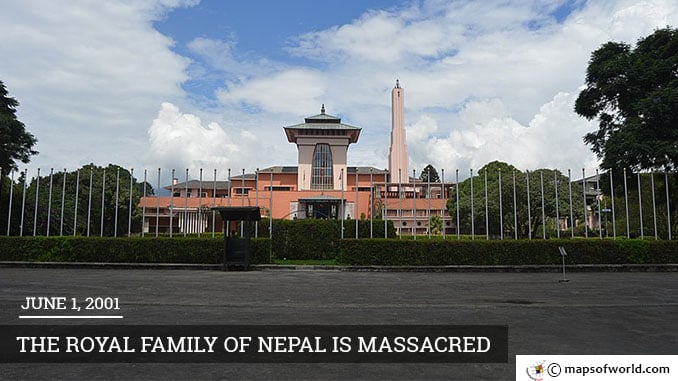On June 1, 2001, the Crown Prince Dipendra of Nepal sent the country into shock and sorrow as he went on to massacre the king, queen and several other members of the royal family, before turning the gun on himself. 29-year-old Crown Prince Dipendra killed Nepalese King Birendra and Queen Aiswarya, his 22-year-old brother, Prince Nirajan, and sister, 24-year-old Princess Shruti among other royals in the grounds of the Narayanhity Royal Palace. The Narayanhity Royal Palace in Kathmandu was the residence of the royal family at the time. The prince’s action was attributed to a conflict with his mother over his choice of bride. Eleven people died in the incident which started when Crown Prince Dipendra allegedly had a dispute with his mother over his choice of bride. King Birendra’s sisters Princess Shrada and Princess Shanti and his brother-in-law Kumar Khadga were also killed in the terrible tragedy. The only person from the royal family who had been left unharmed in the incident was the King’s middle brother Prince Gyanendra, who had been traveling out of the country at the time. Despite the passage of over a decade, the massacre of Nepal’s royal family remains a widely debated issue, shrouded in mystery. A number of conspiracy theories surround the tragedy. Popular belief in the country rejects the opinion that the crown prince was a mass murderer who launched a crazed act of violence in an alcohol- and drug-fueled stupor. The official investigation committee submitted a 200-page report, blaming Crown Prince Dipendra of the violent act but failed to adequately establish the cause of his fury. The queen’s opposition to Devyani Rana, Dipendra’s sweetheart and her threat to disinherit the prince was mentioned, while leaving a number of loose ends. None of the victims’ bodies were sent in for postmortem. The statements of witnesses could not corroborate the weapon used by Dipendra for the massacre. The official investigation report also failed to elucidate whether the Crown Prince had killed himself or was murdered. The committee found a bullet wound to the left side of Dipendra’s skull but the prince himself was right-handed. The crown prince was said to be in coma for three days before he died. Much public hysterics and outcry followed the incident in a country where the monarch is revered as an incarnation of God. King Birendra’s middle brother Gyanendra was suspected to be the master mind. Gyanendra’s son, Prince Paras escaped the episode unhurt while his wife Komal survived a bullet wound fuelling speculations. Eventually Gyanendra was crowned king. The air of suspicion and mistrust was never completely dispelled. In 2008, following a popular uprising, monarchy was abolished in Nepal. However, King Gyanendra did have his supporters. Ketaki Chester, King Birendra’s cousin and a survivor of the massacre declared both Gyanendra and his son Paras free of any blame. Nepali author Manjushree Thapa wrote in her popular historic book, Forget Kathmandu, “Most Nepalis will conclude that we just don’t know what happened on the night of 1 June 2001. We lost the truth; we lost our history. We are left to recount anecdotes and stories, to content ourselves with myth.” Also On This Day: 1926 – Marilyn Monroe is born. 1934 – Nissan Motor Company is founded. 1942 – News of Nazi extermination camps becomes public. 1958 – Charles de Gaulle resumes French leadership. 1968 – Hellen Keller dies.
June 1 2001 – The Royal Family of Nepal Is Massacred
On June 1, 2001, the Crown Prince Dipendra of Nepal sent the country into shock and sorrow as he went on to massacre the king, queen and several other members…
